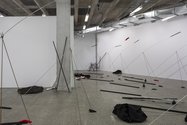John Hurrell – 29 February, 2016
In Gallery One the textured grey floor seems to be a plane of prime importance with its polished concrete and inlaid specks of fine grit and assorted pebbles - like a ground down riverbed. It dominates so that the height of the brutalist concrete walls bordering it is not accentuated. This, and the grey ceiling, somehow keeps the verticality of Rhodes' installation compressed on a restrained, relatively shallow, level: not soaring but prodding and pushing horizontally.
It is a significant event to have Banks Peninsula-based, veteran installation artist Pauline Rhodes displaying a large work in Auckland - her presentations in this part of the country are rare. And although she lost a huge percentage of her bank of recyclable materials in the 2011 Christchurch earthquake, this AUT show has strong similarities with various installations she presented in the early eighties, such as Extensum/Extensor in Christchurch’s CSA in 1983, with Dark Watch‘s leaning vectors lancing the air as they advance away from the building’s foyer and curve round towards Gallery One’s inner corner window.
Vaguely anthropomorphic, these pyramidal linear configurations stand for guardians or watchers of the natural environment, symbolic sentries that Rhodes has been thinking about since the mid seventies. These standing structures could also be taken as satires of trig-stations, but the black or red rags wrapped round the extending tips have a more serious mood. Resting on the front ends of darkly stained cedar boards that are like safety planks extending across a swamp or area of quick sand, and leaning forward to rest on two black cedar triangles, the ‘figures’ occasionally hold aloft Rhodes’ characteristically rusted hanging strips of cotton fabric, marching alongside crumpled forms of rusted black polythene, and caches of rusted concertina-folded paper. Now and then there are flashes of fluorescent green rod tips to offset the dominant black and white palette, the dark bars activating the floor, the undulating rag lines hovering above to be seen against the white walls.
Using an unusual mix of small plastic cones to hold up the cedar boards - pinioned mesh rectangles jammed underneath - and various handmade forms (to evoke grass-height landscape) casually spread across the floor and around the ‘watching’ sentinels, Rhodes generates a sense of improvisation, advancing movement and continual change. Sometimes wirenetting is entangled with similarly coloured, springy dried bushes, or rolled into buckled, rust-stained, paper tubes that could be robust, snapped-off branches. Now and then pairs of crossed black poles lean against the walls.
With Rhodes the fine detail in her seemingly ‘scattered’ installations is important, as is its positioning. Tightly wrapped tubes of unreadable printed text become fine rods that visually mingle with the stainless steel ones that serve as struts. In Gallery One the textured grey floor seems to be a plane of prime importance with its polished concrete and inlaid specks of fine grit and assorted pebbles - like a ground down riverbed. It dominates so that the height of the brutalist concrete walls bordering it is not accentuated. This, and the grey ceiling, somehow keeps the verticality of Rhodes’ installation compressed on a restrained, relatively shallow, level: not soaring but prodding and pushing horizontally.
It’s good to see a sprawling installation like this in Gallery One. Rhodes has in the past made more spectacular shows, but this ‘vector’ work works well with the St Paul St Gallery floor and corner window, and is pitched perfectly, without superfluous distractions on the walls. It needs several visits to grasp the structure of the raised up configurations (the two heights) and the intricacies of their compositional alignment.
John Hurrell







 Advertising in this column
Advertising in this column Two Rooms presents a program of residencies and projects
Two Rooms presents a program of residencies and projects



This Discussion has 0 comments.
Comment
Participate
Register to Participate.
Sign in
Sign in to an existing account.